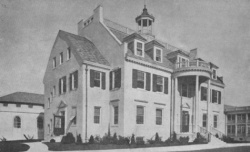Essex County Sanatorium
| Essex County Sanitarium | |
|---|---|
 | |
| Opened | 1928 |
| Closed | 1964 |
| Demolished | 1976 |
| Current Status | Demolished |
| Building Style | Cottage Plan |
| Location | Middleton, MA |
| Alternate Names |
|
History[edit]
The first published report on tuberculosis in the United States was compiled in 1889 by the New York City Department of Health. Commonly known as consumption or “the white plague”, the bacterial lung infection known as tuberculosis grew into a global epidemic after the close of World War I. Massachusetts, along with many other states, expedited construction of county sanatoriums specifically for the care of patients with active TB. Salem officials agreed that the town of Middleton was the best location since it was located on a hill, with plenty of open air and just 2 miles north of Danvers State Hospital. Three years later, John H. Bickford designed the the Essex County Tuberculosis Sanatorium. The facility opened on May 26, 1921 and occupied over 88 acres, just 2 miles north of Danvers State Hospital.
“The San”, as it was often referred to, was filled to its capacity—350 patients- in its first year of operation. During this time, the closest sanatoriums were in Rutland, MA and Hebron, Maine. Ten years later, the Middlesex County Tuberculosis Sanatorium in Waltham, MA opened in 1931 to relieve overcrowding in the other facilities. The treatment of pulmonary tuberculosis in the 1920's was rudimentary. Sulfa drugs and penicillin, as well as certain forms of surgery, have eliminated the need for long periods of hospitalization, allowing for better management of the disease.Patients at the San were doctors, lawyers, clergymen, bank executives, insurance agents, and even undertakers. There were fishermen from Gloucester, tannery workers from Peabody, stone cutters from Rockport, shoe workers from Lynn, and many others. The ages varied from as young as 7 to as old as 80.Dr. Olin S. Pettingill was The San's first Superintendent. Dr. Pettingill (1882-1969) worked at the following facilities and dedicated his life to the study and elimination of tuberculosis:
Assistant Physician Rutland State Sanatorium, resigned in October 1914
Assistant Superintendent at the Rhode Island State Sanatorium at Wallum Lake 1914- Dec. 1915
Superintendent State Sanatorium Hebron Maine 1916-April 1921
Superintendent Essex County 1921-1937
When he transferred to Middleton, he brought with him an already assembled staff of nurses and doctors from the Hebron facility where he served as superintendent for five years. The majority of the staff members lived on the hospital grounds in the Webb House which was located where the Essex County Correctional Facility now stands. The treatment of pulmonary tuberculosis was quite simple: good food and plenty of rest being the initial cure. It was typical to see patients covered in layers of clothes and blankets, the windows wide open even during the winter months-- fresh air and relaxation were the keys to recovery. Like many other institutions, The San kept the male and female patients separated. The male patients were at one wing and females at the opposite wing. The Essex Sanatorium was also completely self-sufficient. It had its own power, heating, and water supply along with livestock, and fruit and vegetable farms located west of the property. In 1960, as the number of active tuberculosis cases lessened, the Sanatoriums expanded to treat other chronic disease patients. Eventually the chronic disease patients were moved elsewhere, and the last tuberculosis patients were moved to the Middlesex County Hospital in July of 1964.
The buildings sat abandoned for over a decade. During those years, the San had its share of homeless living in the buildings, vandalism and numerous fires.
In the summer of 1968, a doctor’s home was set on fire
A fire destroyed the superintendent's building on November 4th, 1969. The superintendent's building was immediately demolished as a result of the fire damage.
December 23, 1969 the interior of the former administration building was set on fire
The male dormitories were set on fire on Saturday, March 31, 1973
April 1, 1972 firemen worked five hours to put out a fire at the San’s Web House, a dormitory for married couples.
Late April 1972 a barn behind the Web House was destroyed by fire.
June 6, 1972 a small summer house of the former superintendent of the prison farm, adjacent to the San complex was gutted in a 2-hour blaze involving 21 firefighters
Middleton officials expressed repeated concern in those final years over the strong possibility of a fatal accident on the San grounds as the town answered fire call after fire call. Finally, the County Commissioners put up the funding to have the structures razed. In January 1974, the entire campus was demolished. The state put the property up for sale and struggled for many years to find a buyer. Out of the 88 acres that were up for sale, MIT purchased a portion of the land and the Essex Agricultural & Technical School purchased another portion. After many years of back-and-forth debates with the people of Middleton and County Commissioners, the Commonwealth of Massachusetts purchased the remaining acres and the Essex County Correctional Facility (Middleton Jail) opened in 1991. The opening of the Middleton House of Corrections resulted in the closing of the Salem and Lawrence jails. "[1]
Images of Essex County Sanatorium[edit]
Main Image Gallery: Essex County Sanatorium
References[edit]
- ↑ John Gray, "Essex County, Middleton, Massachusetts." https://www.middletonsanatorium.com/.






